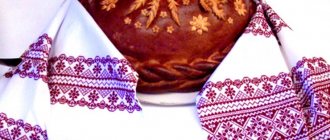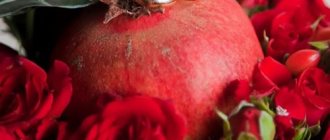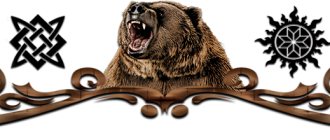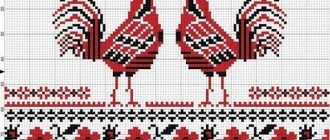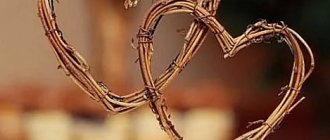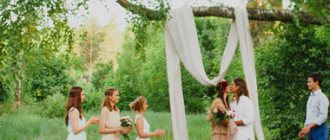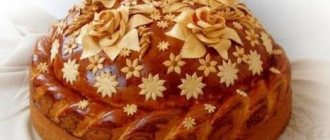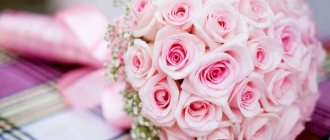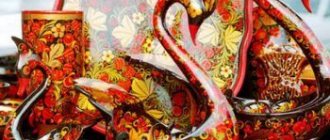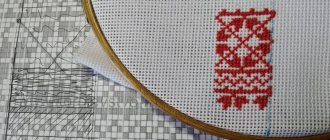A towel is considered one of the most important wedding attributes. Many traditions have not survived to this day. But towels for weddings are still purchased regularly. There is no way without him.
It is better to do such an important attribute yourself. A hundred years ago, such a question did not arise before either a noblewoman or a peasant woman. The towel under the feet had to be embroidered exclusively by the bride herself. The whole fate of the future family rests on him. This is the main amulet that has never been shown to outsiders.
Tips and tricks for use
And a few more rules for embroidering a wedding towel.
- You should not throw away a towel from a loaf, nor should you give it as a gift. This can destroy family relationships and there will be no happiness in the family. The towel must be stored carefully (just as a couple treats their family).
- The towel should not consist of several pieces (only a single piece).
- It is forbidden to embroider horizontal lines above the top of the pattern - this provokes divorce and childlessness.
- Always be hands-on before embroidering the fabric (needlewomen note that this eliminates negative thoughts).
- Threads made of silk and wool are suitable for towels (only natural ones, it is better to avoid artificial ones).
- Thursday is an ideal day for embroidery; it is better to do needlework in the morning. The front side and back should be the same, or the back should be neat. This will allow you to find harmony between the material and spiritual world.
- There should be no patterns in the center (middle) of the towel: the priority is the space and emptiness of the “white sheet”.
- You should embroider only those designs that the bride likes. If a particular pattern does not bring positive emotions, you should replace it with another.
- A wedding towel is kept by a married couple all their lives and then passed on to their children, who use it at their wedding. This tradition inspires many brides to create towels with original hand embroidery.
The loaf on a beautiful towel becomes even tastier, and the impressions of the event remain only positive. And photographs from the scene of the event will give a sea of pleasant memories that the couple will keep in their memory for a long time.
How much does it cost?
The price range for these accessories starts from 150 rubles on average (in Moscow) - this is color printing on a textile product, and an embroidered towel with a minimal pattern costs from 300 - 700 rubles.
The splendor of the design, the quality and length of the canvas, and the fame of the manufacturer affect its cost. You can buy a towel for a loaf from a clothing factory for 1300 – 1800 rubles. When placing an order, production times are taken into account. Machine embroidery is done faster (from 3 to 7 days, if it is not the height of the wedding season).
The meaning of the towel
A wedding towel is an indispensable element during a wedding. It is used during wedding ceremonies and for meeting newlyweds after the registry office. A towel is a decorative embroidered towel, usually made of linen, cross-stitched or satin stitch, and decorated at the bottom with lace or fringe made of the same fabric.
The wedding towel takes place in many Slavic rites, and the name of the matchmaking ritual in various regions is associated with it. It is called giving towels, taking, giving or simply towels. They are an invariable attribute of matchmaking and symbolize the girl’s consent to marriage. They tie it around matchmakers or offer bread on a towel. In some areas, the tradition of the betrothal ceremony has been preserved, during which the bread is covered with a towel and all relatives who take part and the young people put their hands on the towel, and the headman ties them with a symbolic knot, accompanying his actions with special words. After this, the knot is untied, and the matchmakers are tied with towels and given gifts. A young family must keep a wedding towel for the rest of their lives.
Prices for wedding towels
Ceremonial items for a wedding ceremony are strictly prohibited from being rented. You need to embroider them yourself or purchase finished products. Event supplies are sold in sets and individually.
The price of one copy depends on the quality and length of the fabric, the splendor of the embroidery, and the reputation of the manufacturer. The cheapest products are made of textiles with color printing. The highest cost is for handmade work by professional craftswomen.
A wedding towel is one of the most ancient amulets for a young family. The path of the canvas has a symbolic meaning of fate, protection, the road to a new happy life. Embroidered signs, ornaments, patterns and symbols further increase the significance and power of the relic.
Traditions
The wedding towel under the feet and the signs associated with it are the most important part of the wedding, so the bride once worked for several months on its creation. Today, towels are more often bought for weddings, so they are either made by machine or by a handicraftswoman. Very rarely today a bride embroiders a wedding towel.
Once upon a time, in the process of preparing for the wedding, the bride had to embroider more than 40 towels with her own hands. According to tradition, a wedding was a complex ritual where two families were united and a program for the future of the couple was created. And for each ritual there was a separate towel.
The most important towel is the one that is placed under the feet of the couple during the wedding in the church. This towel is a symbol of a special atmosphere and a special time. The towel was decorated with paired patterns: a pair of birds, garlands. The main color is red (symbolizes beauty, life, love).
The list of obligatory towels, without which a wedding cannot be complete, includes:
- Basic;
- Union;
- Hospitable;
- God.
The wedding “under your feet” is used everywhere: both in the registry office and during a wedding in a church. It is spread out in front of the bride and groom when the couple stands on the towel, thereby expressing their desire to get married. The couple stands on the towel throughout the ceremony. The bride and groom should try to stand in the middle of the towel, where there are no patterns or embroidery. It is believed that this is God's place where the couple receives blessings. You should not step on the patterns. If someone steps on the pattern of a pair of birds, it means they will trample family life.
Therefore, this pattern is rarely used in embroidery. And they replace it with plant, floral, geometric patterns. There is a clean, large area left in the middle where both partners can fit.
Previously, people stood on their knees while wearing a towel. Today they are stepping on him. It is believed that the one who first puts on the towel will become the head of the family (this ceremony is carried out when leaving the church, when entering the new home of a young family)
When a towel is placed under the feet of a couple, it is important that no one steps on it before the bride and groom. Today people have little faith in omens or believe
But not as much as before.
Other signs of a wedding towel relate to its appearance and features of creation/embroidery:
- There should be no drawings in the middle of the towel, because... these are obstacles and hindrances in married life.
- You shouldn’t sew a towel from several pieces if you want your family to live happily, well, and everything goes smoothly.
- Before embroidering, you should wash your hands and do embroidery in a peaceful state. And while creating a towel, the bride should think about the good.
- You should embroider a towel on Thursday morning, only at the beginning of the day, when the sun rises.
- You need to embroider with the same needles with which the embroidery began (then family life will pass without losses or problems).
Towel under your feet
He is perhaps the most important person at the wedding ceremony, because it is he who decides how the future life of the new family will turn out. In the registry office during the marriage process or in the church during the wedding, witnesses spread a “wedding” white towel on the floor in front of the newlyweds, on which they stood. The center of the cloth should remain white, thereby personifying the connection with the cosmos. The towel symbolized a white cloud on which the bride and groom seemed to ascend to the Kingdom of Heaven, where the Lord himself blessed their marriage and sealed it with the sacred bonds of marriage. Therefore, it is forbidden to embroider rings, flowers, the wish “For good luck!”, or two birds symbolizing the newlyweds on it, because when the bride and groom stand on such a towel, they will trample on everything good that could be in their family future. The best option for embroidery on a wedding towel is a floral ornament or a geometric pattern. If a girl decides to embroider a towel by hand, then under no circumstances should her mother or sister help her, otherwise her son-in-law will be turned away (discouraged).
Traditions and their role at the celebration
All nations have their own traditions and rituals filled with symbolism. Over time, traditions changed. But there are basic ones that are the most significant and popular.
- Parental blessing. She has many options. The parents of the bride and groom bless the couple to create a new family and give verbal guidance.
- Meeting with a loaf of bread. Parents meet with a loaf of bread in their hands, inviting the couple to break off a piece. The one whose piece is larger will take the place of the head of the family. Read more about this here.
- Removing the veil. Signifies the acceptance of a new family member (acceptance of the bride). Everything basically happens in a playful way.
- Dance of the bride with her father. Here you can get ideas on how to make dancing with your parent even more memorable.
Traditions unite families, allow them to find strength in communication between generations, give a feeling of reliability, and show that a couple belongs to a certain nation or social class.
What is a towel like?
A towel is a richly embroidered and decorated rectangular cloth made of linen or hemp, about 35 cm wide and 1.5 to 5 m long.
The product is decorated with embroidery, lace, ribbon or satin ribbons.
The images on the canvas are arranged symmetrically and on two sides, with one half dedicated to the bride and the other to the future groom.
How to choose?
When choosing, follow simple principles:
Towels with a colorful print should not smell like paint; It is better to purchase from the moment you submit your application to the registry office. There are 2 explanations for this. Firstly, the bride will have other worries. Secondly, there is a possibility that it will take a long time for this accessory to be produced.
We must take into account the seasonality of weddings;
They don’t take used towels, which is considered a bad omen; It is important that the length of the product is divided into 7 equal parts - this is required by custom.
Brides should take into account that the main advantage of a factory-made product is the guaranteed accuracy of the pattern on both sides. However, only a towel that has been custom embroidered by a master can be unique.
Sizes of towels
According to tradition, the size of a wedding towel is divided by 7 without a remainder. The length is divided into three equal parts and the middle, one third, must be left white. Nowadays, few people adhere to this rule and choose a white canvas 2 to 3 m long for towels “under the loaf” and “under the feet”. But in the center there must be an empty space for the bride and groom to step into, and plus the rule of the design quarters of the towel, so the length in width is from 45 to 50 cm. The width of the towel is determined by repeating the pattern, and the length is determined by the amount of embroidery (the free space in the middle should be enough for the feet of the newlyweds). The towel is hemmed by hand, grasping the base thread through the cross, so that a dotted line is created on the face only if a fabric without an edge is used for it. The hem depends on the fabric, for example, calico or linen is folded 0.5 cm 2 times. The design should be symmetrical and there should be no white border on the sides. The sizes of towels “for icons” and “union” are: length from 1.8 to 2 m, and the width of the towel depends on the pattern.
How to choose?
The ideal option is to make your own wedding towels. This responsibility falls entirely on the shoulders of the bride. A girl should decorate a product exclusively with a positive attitude, thereby charging it with positive energy. Self-embroidered towels cannot be compared with purchased ones. But if the bride does not have the time or ability to embroider, then it is worth ordering products from professionals or buying a ready-made version in a specialized boutique.
When choosing a store towel, you should pay attention to several recommendations from experts
- When choosing, it is worth not only starting from the cost and appearance of the product, but also taking other indicators into account. For example, the fabric should be solid - it is necessary to exclude options with hemlines or lace. When choosing a size, you need to ensure that the length and width are divisible by seven. Embroidery should be present mainly on the edges of the product.
- It is worth giving preference to towels decorated with rings, birds, flowers, and trees. Such options can be used for a ceremony both in a church and in a registry office. And don’t forget to have the sign of the cross everywhere.
- Before purchasing, the product must be checked for quality. Its edges should not be torn or cut off. The two sides must be the same, because it is accepted that the front side is intended for people, and the back side is for God.
- The best option for a loaf is a towel, in the center of which the loaf will be located, so there should be no embroidery here. Usually embroidery is presented on the edges of the product.
The emergence of the tradition of using towels for weddings
Previously, brides embroidered towels with their own hands. The girl sat over her creation for days. For these purposes, a piece of linen fabric was used. The name comes from the word “rushiti”, because they embroidered patterns on a torn piece of cloth.
In the old days, it was customary to marry off young girls, so the responsibilities of the future wife were taken on by her relatives. They embroidered towels and prepared wedding attire. They had an important task - to complete the painstaking work on time so as not to let the young bride down.
At this time, the bride did not rest or have fun. She also had her own responsibilities and worries. There was an opinion that the chosen one of the future bride, who became a guest of her house for the first time, first of all looks for embroidered towels with his eyes. The patience and perseverance of the young girl were assessed based on the masterpieces they noticed.
The wedding towel, which has long been considered a pagan symbol, was also adopted in the Orthodox Church. This towel can be purchased in modern salons and in shops that operate at churches. You can also order a towel for your wedding from a professional needlewoman who will embroider the patterns you choose.
Beautiful examples
For a loaf of bread, a towel decorated with the inscription “bread and salt” would be an excellent solution. Red and black threads harmonize perfectly with each other, although red is used more. This product is not distinguished by the sophistication of its pattern, but it looks very gentle and cute.
This wedding towel will be an ideal choice for a wedding. Swans, two rings and floral patterns complement each other perfectly. The product looks rich, solemn and stylish.
The wedding towel for the icon differs in size and brightness of the design. Leaves, berries, flowers and birds add richness to the product and represent love and happiness.
To learn how to make a towel-towel, watch the following video.
Belarusian towel schemes
One of the distinctive features of Belarusian ornaments is the use of geometric shapes: squares, stars, circles, quadrangles, rhombuses, stripes. Sometimes such patterns smoothly transform into plant motifs. Floral ornaments were mainly depicted: flowers (most often acacia, lotus), leaves, fruits (grapes)
Another distinctive feature of Belarusian towels is the absence of symbols of death. For Belarusians, the pattern on embroidered items acts as a talisman; it must carry a positive charge. Initially, the ornament was embroidered on a white background using red threads. It is believed that only this nationality managed to preserve the type of patterns that existed among the ancient Slavs. White color is a symbol of purity, openness, red is vitality, blood, sun. Much later, black color appeared in ornaments, but it was used little. The main symbols of the Belarusian towel:
- tree of life - a sign of immortality, eternal life,
- Yarilo on horseback is a symbol of the vital forces of nature, fertility,
- A woman of life is a sign of fertility, harvest,
- symbol of ancestors - a pattern that represents a petition, a prayer to God for one’s relatives,
- sun sign,
- symbol of a child - a talisman sign for children,
- the sign of the Mother is a symbol of all living things,
- Beregini's symbol is a sign of family farming, handicrafts,
- a sign of wealth - a symbol of a wish for wealth, prosperity, offspring.
Storing towels after the wedding
A husband and wife who got married in a church should under no circumstances give or throw away towels. Otherwise, you will independently destroy strong family relationships, and there will be no stability and happiness in your family. They need to be stored very carefully. Treat them the same way you treat your family relationships. Towels, which were useful in the registry office, can only be given to your grown-up children on the eve of their wedding. This exception was made by pagan ancestors. Over time, it passed into Slavic culture. This tradition is observed by almost every family.
If you start to quarrel often, then you need to take out wedding towels, completely relax and look at the intricate embroidered patterns. You will immediately forget about quarrels, resentment and misunderstandings. It will immediately become clear to you that family happiness is the most important thing in the whole world.
You can turn the towel into a kind of symbol of your own. To do this, the attribute must be passed on by older family members to the younger generation. This way you can bless your adult children. Wish them a happy life with their significant other. Let this become the hallmark of your family!
Embroidery of Slavic towels patterns
The process of creating towels is creativity, magic. When creating embroidered work, craftswomen not only put into it skill, energy, charge, but also their soul and love. Therefore, an embroidered towel is not just a beautiful thing that pleases the eye, but also an object that can become a talisman for a person, helping him to recharge himself with positive strength.
Since ancient times, Slavic culture has distinguished several types of towels, each of which performed its own function:
- Handbrake - it was used to wipe the face and hands. These products were embroidered in a special way, the main patterns were swastikas, and later rhombuses. At the same time, when the lower edge was embroidered, wide stripes were embroidered first, then narrow ones, and the upper edge, on the contrary, was embroidered from narrow to wide stripes. This pattern meant the rising and setting of the sun, which is why they wiped themselves with such a towel according to a special ritual: in the morning they wiped their face with the lower end, and in the evenings with the upper end. They believed that in the morning a person received strength, and in the evening he relieved fatigue with a towel.
- A fly is a small towel-shawl. Often embroidered with white thread. This type of towel was used by the bride to wipe away her tears; it was tied on the bride’s hand when she was taken away from her parents’ house.
- Bozhniks are towels that were used to decorate icons.
- Maternity - a towel in which a child was received at birth.
- Podorozhny is a towel that was given to people leaving their home. A simple but thoughtful pattern was embroidered on them, the symbolic meaning of which was the wish for an easy journey, a successful return home.
- An ordinary one - a towel, which was embroidered over the course of one day. It was believed that such products had protective functions, because they were made during the day, when bad forces had no power. Such towels were created only when necessary; they were not embroidered in advance, so they were used only for a specific purpose (cattle were driven through such a towel to avoid diseases, a road was laid out for rain during drought).
- Wedding - there were several types of such towels, each of them performed its own task.
- Funeral - they accompanied a person on his last journey, they were hanged on graves. They embroidered modestly, just a narrow strip along the edge, often with white thread.
Video on the topic
Everything you need to know about wedding towels in the video from the Love-Carrot Wedding Events Studio:
By thinking through such wedding details as a towel and a loaf, you pay tribute to traditions and demonstrate to the older generation that this has meaning and special meaning for you.
You don’t have to embroider a towel for a loaf yourself; it’s easier to buy it at a wedding salon.
You will need a set of several towels if you are planning both a wedding and a meeting with your parents. It is better to order a set in one style (the accessories do not have to be embroidered; the products can have typographic designs).
Meaning, symbolism, origin
The cult of bread and the special attachment of people to grain has created a wedding tradition that involves a loaf of bread. Therefore, this element has long been used at weddings. The loaf symbolizes wealth and fertility. The loaf should be round. In this case, the young family receives a blessing for a life of abundance.
The newlyweds were greeted with a loaf of bread after the wedding (the bread was eaten from the middle, this is symbolic, because it resembles the origin of life). After the couple had tasted the bread, the loaf was offered to relatives and guests, who could also try it. Anyone could taste the loaf and give something in return (make a present for the young people).
All guests receive their own piece of loaf, which they can share with their family at home. Everyone who tries a loaf gets good luck (especially in new business, road or travel). Loaf decorations are distributed among unmarried girls, thereby wishing them happiness in their personal lives and a speedy wedding.
How to make a wedding towel for a loaf - the diagram below shows:
How to embroider a wedding towel: YesYes gives a lesson
Undoubtedly, you can buy all the necessary towels in the store, fortunately, now there is no shortage of these and the prices are quite affordable. You can read about this in our article below.
But if you feel such a need and necessity, you have free time and you know how to do it, then wear a towel yourself. At least one. You and your loved ones will be proud of this work!
And YesYes will help you.
Embroidery rules:
1 In a specialized store you buy fabric for cross stitch: 2.5-3 meters long and 50 cm wide. Calculate the length like this: there will be a pattern on the sides (40cm on both sides), and you and the groom should fit in the center.
2 You need to come up with your own design - everything you want to depict on the towel.
3 The pattern on both sides of the towel is absolutely identical and symmetrical.
4 You cannot embroider rings or birds on the wedding towel - you will be standing on it with your feet. It is better to use floral patterns or geometric designs.
5 On blessed towels, the ornament is embroidered ONLY with red threads.
6 For the union towel we use a floral ornament, embroider “Advice and Love” and the names or initials of the young people.
7 For the loaf, embroidered doves or larks are suitable - always in pairs, and bright, red flowers (at the bottom - large, then smaller, and at the top - unopened buds) on green branches. You can also embroider the loaf itself.
8 Embroidery should have three levels:
- below: family tree with birds
- middle: blessing for the young
- top: amulets (male and female) and names of newlyweds
Symbols and their magical meaning
Different parts of Ukraine have their own rules and traditions of embroidery. There are also a huge number of symbols; we will focus only on a few, so to speak, unified ones that will suit any embroiderer. So, what are the symbols and what magical meaning do they contain:
A bunch of grapes - happiness and well-being of a new family
Oak is a man’s amulet, a symbol of his strength and courage.
Viburnum is a woman's amulet, a symbol of her health and beauty
Red berries – longevity of family and newlyweds
A dove or a lark - only in pairs, with their heads turned towards each other and a green twig in their beaks - the love of the young and the birth of a new family
Swallow - depicts the good news: the birth of new love
Peacock or firebird - symbols that bring happiness and peace to the home
The rooster is always red - a symbol of wealth and health
Sprigs of hops - prosperity, youth, happiness, love
Rose is a symbol of divine light and the desire to move forward
Poppies - continuation of the family
Carnations – fidelity, devotion and tenderness
Mallows - purity, beauty, chastity
The words “For happiness”, “For share”, “Love and advice” are also very often used in embroidery, but they need to be placed below the main design.
Basic laws of towel embroidery:
For a towel, you need to take ONLY a whole piece of fabric, then your family life will never be torn apart. While working, you are visited by kind, bright thoughts - you think with tenderness and love about the people closest to you. Clean, well-washed hands, like clean thoughts, give positive energy to your creation. Material - natural fabric, threads - only wool or silk, there must be harmony with nature, no artificiality. If you make a slight mistake while embroidering, don’t correct it or rip it apart—that’s not customary. Try to embroider a towel on both sides
This is quite painstaking, but very important: a double-sided towel is a symbol of the harmonious unity of the spiritual, divine world and the material, natural world. The middle of the towel always remains free, untouched - the bright, pure power of God passes through it. It is strictly forbidden to sew a hemstitch or insert all kinds of lace into a towel - the towel must be inseparable. Always embroider with the same needle, so try not to break it or lose it. First, the right side of the towel is embroidered - the male side, and after that - the female, left side. Think carefully about your design and embroider the plot that is closest to you... And most importantly: it is customary to start embroidery on Thursday and only in the morning
And most importantly: it is customary to start embroidery on Thursday and only in the morning.
Wedding ornaments for towels
Most often, the image of the tree of life is used on wedding towels as a symbolic infinity of the family, a symbol of a strong family and a wish for a happy family life. A pair of embroidered doves is also popular, symbolizing strong love. The ornaments are based on a cross, which is a symbolic representation of the sun, goodness, happiness and light.
Plants are often embroidered on wedding towels: grapes, symbolizing rich life and fertility; viburnum - a symbol of women's health and beauty, marital fidelity and longevity; oak, the personification of male energy and strength, wealth and fertility; The poppy is a symbol of well-being and procreation.
The image of a lily is a symbol of female beauty, purity and innocence, and its bud with leaves symbolizes the emergence of a new married couple. True, sincere love is expressed by the image of a rose. Flower wreaths symbolize the path of life.
In addition to doves, wedding towels can depict a swallow (strong family economy), a firebird or a peacock (family happiness). The crown embroidered on the towel is a symbol of God’s blessing.
Do-it-yourself towel embroidery
The embroidery should be different on both edges of the towel. One is for the future spouse, the second is for the future wife. What remains common is the design itself and the size of the decorated part.
Embroidering must be done in three stages.
The first stage includes the design of the genus tree. Trees with a couple of birds are also embroidered with it.
The second stage is a wish for the newly made couple.
The third is bereginii.
And it all ends with a wedding wreath with the initials of the couple.
Embroidery should follow the following rules: the border is made first. Its appearance can be varied - imitation tassels or lace. Lace can be either sewn on or pulled out and decorated in the form of tassels.
Next, you can begin to design the family tree, alternating with trees on which paired birds are located. Trees can be very diverse - with swallows, doves, unknown animals similar to deer, but always under a tree. Peacocks are the most popular species right now.
Next, there should be a stitch with wishes to the newly-made couple. A rose is decorated for the girl, symbolizing grace; lily, symbolizing chastity; a carnation, denoting devotion; poppy, symbolizing the appearance of offspring. For a man - grapes - prosperity; oak - power; viburnum - continuity of married life. The main motif is stitched with stitches from minor patterns of the corresponding theme. During the work process, the lines should be combined with a print that includes a cross. Eg:
There can be many variations, depending on the imagination and desire of the needlewoman.
Next, bereginii are decorated - these are small stylized trees in pots. There are options without them. Embroidery should be done on both sides of the towel, while maintaining the middle for the wedding ring, which should be completed with a crown, denoting a church wedding.
In the middle of the ring you can embroider the initials of the newlyweds.
Bereginya sample:
Cross sample:
Ring sample:
Initials can be embroidered in a variety of fonts.
Satin stitch embroidery towels patterns
Satin stitch embroidery provides more opportunities for creative freedom. In fact, you can embroider any design; you just need to transfer it to the embroidery fabric. For satin stitch embroidery you need several basic tools and materials:
- needle (must have a sharp end),
- frame (hoop),
- threads (matched to a specific fabric),
- fabric (smooth or counted).
There are several directions for satin stitch embroidery:
- Russian satin stitch - stitches are laid either horizontally or vertically, a gap of approximately two threads is left between the stitches, and on the way back these gaps are filled,
- artistic embroidery - several different colors are used here to make a smooth transition from one tone to another, embroidery technology - bias stitch without flooring,
- satin stitch - laying thin threads that begin in the middle of the next stitch, close to each other, without gaps.
The main technique for embroidery is the oblique stitch. This technique is characterized by the fact that the stitches are laid close to the second element in shape. In this case, the pattern is obtained from the front and back sides. And in order not to forget in which direction and at what angle to place the stitches, you can simply draw guide lines on the fabric.
Another secret: to get convex, voluminous parts, two layers of stitches are used: the first layer may not be too dense, the next layer is placed on top of this ball, where the stitches are already tightly laid.
What is a wedding towel and what should it be like?
The towel symbolizes the path of life, so it is present in the rituals of the beginning of the path (birth, christening), transition (weddings, getting ready for the journey) and burial (funeral). The canvas was embroidered with patterns-symbols appropriate to the occasion, and decorated with ribbons, braid and lace.
Photo of a towel at a wedding
The main color of the towel is white as a symbol of purity, goodness and protection against evil forces. In this design, the towel served a decorative purpose rather than an everyday one (for example, wiping hands or as a tablecloth for a table).
Embroidered towels for weddings are kept in every Slavic family.
In addition to wedding use, the ancient Slavic towel was taken on the road by military personnel and people going to work so that good luck would accompany them on the other side. At funerals, the body of the deceased was covered with a towel or placed under his feet. As a sign of mourning, the canvas was hung on a window or gate. In addition, the towel served as a piece of clothing in the old days. Women placed it around their heads and called it “namitka.” And the men tied their belts with linen.
It has long been believed that a wedding towel is a strong talisman of family life, and it is better to make it yourself. In Rus' it was believed that it was the bride who was obliged to embroider the towel with her own hands. She seems to be embroidering a pattern for her future family life. Since girls were married off young, in order to have time to prepare everything for the wedding, relatives helped the bride with embroidery.
Photo of towel in Rus'
The fabric was taken whole, which did not consist of several pieces. The ornament was supposed to be continuous, starting from one edge and ending at the other edge, as a symbol of continuous happy life. The groom and his relatives judged the patience, skill and perseverance of the bride by the complexity and grace of the towel pattern.
This type of painting often depicts a pair of birds (doves or larks) as a symbol of love and happiness. Good wishes for the newlyweds and their names are also embroidered on the towel. Floral motifs are always present as a sign of prosperity, the birth of children and happiness. The embroidery color is mostly red. This color symbolized warmth, sun and beauty.
On wedding towels there is often a traditional inscription: “Bread and salt.” In Rus' there was a custom to greet guests with bread and salt on the threshold of the house. Bread and salt mean prosperity and well-being for those to whom the loaf is served, and salt also protects against the evil eye. Guests could also bring bread and salt with them as a wish for the hosts to prosper.
The towel can be any size, but according to tradition, the width and length should be divided into seven parts without leaving a remainder. In Rus', it had a width of 35-40 centimeters and a length of 3-5 meters.
Everyone decides for themselves whether to sew a cloth for the ceremony or buy a towel for a wedding. Wedding salons offer a wide range of these items. Church shops also sell this product. The price of a towel depends on the fabric used and the complexity of the embroidered patterns and on average ranges from 300 to 5,000 rubles. But if you decide to order fabric embroidery from a professional needlewoman, then the towel will cost you even more.
Types of towels and their purpose
This main symbol is always used at the ceremony, denoting the joint life path of the newlyweds. According to popular belief, it represents the key to a strong family. Images and drawings carry various magical meanings, protect the hearth and protect the family.
For the traditional Ukrainian ritual, more than 40 varieties of towels were required. The modern wedding process involves the presence of 5 canvases, differing in purpose, design and method of application.
Hospitable towel for a loaf of bread for a wedding
The product is one of the most striking traditional items of Ukrainian celebration. A festive loaf is placed on it, with which the parents greet the couple after the wedding or painting. This type of textile does not contain any restrictions on execution.
On the sides of the hospitable cloth there are images of a pair of birds. Doves, larks, and peacocks symbolize those getting married who have decided to be faithful to each other throughout their lives. Floral combinations, plexuses of leaves, tree branches and plants are embroidered on canvas as a sign of well-being, prosperity and health.
Cross stitch patterns: wedding towels
Patterns for cross stitching a towel can be found in newspapers and magazines dedicated to needlework, and you can also download ready-made patterns on the Internet. Each scheme is unique, although it contains the same elements. Embroidering a towel is a serious task. This is not just embroidery.
Today, embroidering with ready-made patterns has become much easier. But much in the embroidery process depends on the skill of the needlewoman. Embroidering a towel must be done with special care and scrupulousness.
Symbols for embroidering towels
- Circles;
- Floral ornament;
- Wavy lines;
- Diamonds;
- Eight-pointed star;
- Symbol of the Bereginya;
- Bozhnik;
- Maternal symbol.
The meaning of each symbol is great. Each of them must be performed in a specially designated place on the embroidery. Each symbol contains encrypted messages that help the embroiderer and her family.
Embroidered towels photo
A towel is a canvas (linen, hemp) that is decorated with embroidery.
The towel was embroidered with a specific ornament, which served as a talisman and protection. Each element of the drawing has its own symbolism and carries a certain semantic meaning.
It has long been believed that an embroidered towel has its own power, can help in various situations and protect. Therefore, earlier embroidered products were not intended for beauty, they performed their specific function.
Patterns and patterns of cross stitch for wedding towels
When embroidering a towel, traditional symbols are usually selected, each of them has its own meaning. That is why the pattern must be carefully thought out, because the towel will be a talisman in the family.
Main patterns and symbols of the product:
- Water and sun are a symbol of mother and father, the elements that create all living things;
- Hop leaves are a symbol of love, passion and development;
- Viburnum clusters are a symbol of the longevity of the clan and family;
- Diamonds are a special amulet symbol, very often used when embroidering towels;
- Roses have long been considered a harbinger of love, mercy and respect;
- Grape branches are a symbol of procreation and prosperity;
- Oak is a sign of masculine strength and energy;
- Lily flowers are a sign of female innocence and purity, love;
- Two birds (pigeons) sitting next to each other are a sign of a couple.
Various patterns and symbols are embroidered on wedding towels.
Since ancient times, when embroidering towels, people have followed rules that will contribute to a good and happy family life.
Several rules when embroidering a towel pattern. Before you start work, you need to throw all bad thoughts out of your head, think about a happy future, and wash off the dirt from your hands. The towel must consist of a single piece of fabric.
The empty white part between the towel patterns should be long enough. It is believed that this way the life path of the newlyweds will be easy and happy. When choosing a pattern, you need to adhere to personal preferences
It is very important that you like the ornament. The wrong side of the towel must be done very carefully
“God’s” towel or towel “under icons”
For the bride and groom, the ornaments on the towels under the Holy Faces are different. The only common element is grape leaves with clusters, symbolizing prosperity in the house. On the groom's towel, acorns and oak leaves are embroidered, which represent masculine strength, and on the bride's towel, lilies and viburnum are embroidered, symbols of beauty and procreation, respectively. Be sure to say a prayer before embroidering ornaments: “Creator and Creator of all things, O God, the work of our hands, which we begin for Thy glory, hasten to correct with Thy blessing, and deliver us from all evil, for one is all-powerful and Lover of mankind.” At the end of the work: “Thou art the fulfillment of all good things, my Christ, fill my soul with joy and gladness and save me, for I alone am merciful, Lord, glory to Thee.” Please note that the ornament pattern is at an angle.
Types of towels
Today, the number of wedding accessories has been simplified, leaving 6 mandatory varieties of sacred cloth. They accompany the key moments of the wedding:
- The “hand-beaten” towel was given to the future parents of the groom. If the girl refused, she gave her a pumpkin; if she agreed, she gave her an embroidered towel.
- “The Blessed Ones” adorned icons with which parents instructed young people to live together in love and fidelity.
- A towel under the feet symbolized the beginning of a new life.
- The “allied” bandaged the hands of the bride and groom as a sign of unity. This tradition used to replace what wedding rings are made today.
- The “God’s” sacred cloth was intended to decorate the icons that the newlyweds held during the wedding.
- A “hospitable” towel is the embodiment of wishes for prosperity and well-being. His embroidery differs from the rules for applying patterns.
The key role of the accessory is to attract wealth and demonstrate respect for another wedding shrine, the loaf.
Only women who were happy in their married life kneaded it, so no one else was allowed to take the wedding bread with their hands, it was considered a bad omen.
The loaf cloth is distinguished by lush patterns, inscriptions that come from antiquity, such as “Bread and salt”, and modern ones, for example, “Advice and love!”
Important! Previously, more attention was paid to this type of ritual towels: married couples were created not so much on the basis of mutual feelings, but on the material security of the other half. Thus, unmarried girls did not skimp on the beautiful design of the canvas, and the word “love” itself was not embroidered; it was embodied by a special ornament in the form of paired birds or flowers
What should a traditional towel be like?
A towel for wedding bread looks like a piece of fabric, in the center of which there should be a loaf. The size of the accessory can be from 42 centimeters to 1.5 meters. The central part of the accessory remains free of embroidery. One fourth of the canvas on the left and right is occupied by patterns and inscriptions with wishes.
Since most modern couples at a wedding ceremony limit themselves to only a wedding towel for a loaf, the canvas is decorated with any embroidery: beads, wishes, symbols of marriage, roses, etc.
In the photo and pictures below, examples of different options for towels for wedding bread and salt:
How many towels do you need for a wedding?
According to ancient tradition, for a wedding you need to prepare not one towel, but several canvases. Sometimes their number could reach 40. During matchmaking, the bride gave the first towel to the matchmakers as a sign of consent to get married. It was the most beautiful and longest. The Slavs also used these embroidered fabrics to decorate wedding carts and the backs of horses.
Photo of a towel for a wedding
In addition, they were presented as a gift to the groom's family . The smallest number of canvases for a wedding is five: for feet, under a loaf, for tying hands, for an icon corner in the house and for a gift from the bride to the groom’s family.
Parents always bless the newlyweds, and for this purpose there is an icon on the towel.
In the old days, such fabric was embroidered by the mother and older relatives of the bride
In addition, you need a towel for a wedding loaf. A towel under a loaf serves as a symbol of happiness and a wish for an easy family life.
Do you know what a towel looks like for a wedding under your feet? During a wedding in the church, a white towel is placed under the feet of the newlyweds. The bride and groom seem to be standing on a cloud before God and making marital vows.
This canvas is considered the most important at a wedding. No inscriptions, flowers or rings are embroidered on it, so as not to interfere with the Lord from binding the young people in sacred marriage. During the ceremony, the priest ties the hands of the bride and groom together with as a sign of unity and fidelity.
Who should bring out the loaf at a wedding?
Who gives the wedding loaf? According to traditions, it is presented by the groom's mother as the mistress of the house into which she receives her son's wife. At modern weddings, it is presented by parents when they meet a new family from the registry office.
Interesting materials:
What do seals eat? What do cicadas eat? What do Achatina snails eat list? What do ampularia snails eat? What do they eat in Japan for breakfast, lunch and dinner? What do they eat in space? What do dolphins eat in Minecraft? What do they eat in the monastery? What do they eat in Shaolin? What do vegans and vegetarians eat?
Example of a Family Tree:
Let's read the drawing: this is the tree of the bride's family, the father and mother are alive; the bride has an older brother, the mother's grandfather and grandmother died (branches from right to bottom), both of the father's parents are alive, the father has no brothers and sisters, the bride has one aunt, because the mother has an older sister. The cloth of a wedding towel must be continuous and whole, because it symbolizes the path of life, so do not insert any ribbons or laces into the middle of the towel, since no matter how hard you try, you cannot sew a cut life back together. After the wedding celebration, the towels are rolled into a tube and kept in the newlyweds’ family as a symbol of a happy family life, so that the evil spirits will walk around in a circle and then realize that they have nothing to do here. All towels, and especially “under the feet,” are used only once. Only the pattern is inherited if the newlyweds live a very happy family life, but a new towel is still embroidered. You don’t rent fate, which means you don’t borrow a towel.
